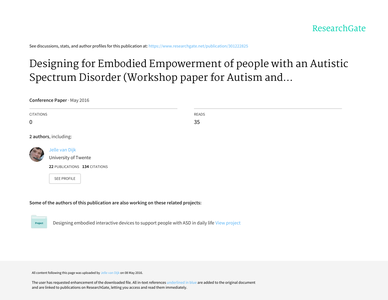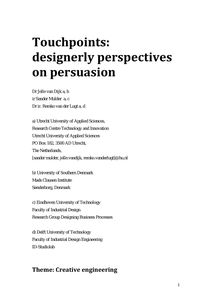Our study introduces an open general-purpose platform for the embodiment of conversational AI systems. Conversational User-interface Based Embodiment (CUBE) is designed to streamline the integration of embodied solutions into text-based dialog managers, providing flexibility for customization depending on the specific use case and application. CUBE is responsible for naturally interacting with users by listening, observing, and responding to them. A detailed account of the design and implementation of the solution is provided, as well as a thorough examination of how it can be integrated by developers and AI dialogue manager integrators. Through interviews with developers, insight was gained into the advantages of such systems. Additionally, key areas that require further research were identified in the current challenges in achieving natural interaction between the user and the embodiments. CUBE bridges some of the gaps by providing controls to further develop natural non-verbal communication.
LINK
This paper introduces a design case that was built around the challenge to design a prototype for women that would positively influence their perception of personal safety in public spaces. The proposed design combines an individual focus with a public impact, influencing emotions through embodiment by introducing a necklace that reminds the wearer to walk straight and as a result, influence felt emotions such as confidence and prevent feelings of unsafety caused by slouching. In this paper, a prototype for wearable technology called PosturAroma is introduced: a fashionable necklace with a sensor that detects slouched body posture and reminds the user to stand straight by giving out a discrete scent.
MULTIFILE
Background: To experience external objects in such a way that they are perceived as an integral part of one's own body is called embodiment. Wearable technology is a category of objects, which, due to its intrinsic properties (eg, close to the body, inviting frequent interaction, and access to personal information), is likely to be embodied. This phenomenon, which is referred to in this paper as wearable technology embodiment, has led to extensive conceptual considerations in various research fields. These considerations and further possibilities with regard to quantifying wearable technology embodiment are of particular value to the mobile health (mHealth) field. For example, the ability to predict the effectiveness of mHealth interventions and knowing the extent to which people embody the technology might be crucial for improving mHealth adherence. To facilitate examining wearable technology embodiment, we developed a measurement scale for this construct. Objective: This study aimed to conceptualize wearable technology embodiment, create an instrument to measure it, and test the predictive validity of the scale using well-known constructs related to technology adoption. The introduced instrument has 3 dimensions and includes 9 measurement items. The items are distributed evenly between the 3 dimensions, which include body extension, cognitive extension, and self-extension.Methods: Data were collected through a vignette-based survey (n=182). Each respondent was given 3 different vignettes, describing a hypothetical situation using a different type of wearable technology (a smart phone, a smart wristband, or a smart watch) with the purpose of tracking daily activities. Scale dimensions and item reliability were tested for their validity and Goodness of Fit Index (GFI). Results: Convergent validity of the 3 dimensions and their reliability were established as confirmatory factor analysis factor loadings45 (>0.70), average variance extracted values40 (>0.50), and minimum item to total correlations50 (>0.40) exceeded established threshold values. The reliability of the dimensions was also confirmed as Cronbach alpha and composite reliability exceeded 0.70. GFI testing confirmed that the 3 dimensions function as intercorrelated first-order factors. Predictive validity testing showed that these dimensions significantly add to multiple constructs associated with predicting the adoption of new technologies (ie, trust, perceived usefulness, involvement, attitude, and continuous intention). Conclusions: The wearable technology embodiment measurement instrument has shown promise as a tool to measure the extension of an individual's body, cognition, and self, as well as predict certain aspects of technology adoption. This 3-dimensional instrument can be applied to mixed method research and used by wearable technology developers to improve future versions through such things as fit, improved accuracy of biofeedback data, and customizable features or fashion to connect to the users' personal identity. Further research is recommended to apply this measurement instrument to multiple scenarios and technologies, and more diverse user groups.
DOCUMENT
Background:Current technology innovations, such as wearables, have caused surprising reactions and feelings of deep connection to devices. Some researchers are calling mobile and wearable technologies cognitive prostheses, which are intrinsically connected to individuals as if they are part of the body, similar to a physical prosthesis. Additionally, while several studies have been performed on the phenomenology of receiving and wearing a physical prosthesis, it is unknown whether similar subjective experiences arise with technology.Objective:In one of the first qualitative studies to track wearables in a longitudinal investigation, we explore whether a wearable can be embodied similar to a physical prosthesis. We hoped to gain insights and compare the phases of embodiment (ie, initial adjustment to the prosthesis) and the psychological responses (ie, accept the prosthesis as part of their body) between wearables and limb prostheses. This approach allowed us to find out whether this pattern was part of a cyclical (ie, period of different usage intensity) or asymptotic (ie, abandonment of the technology) pattern.Methods:We adapted a limb prosthesis methodological framework to be applied to wearables and conducted semistructured interviews over a span of several months to assess if, how, and to what extent individuals come to embody wearables similar to prosthetic devices. Twelve individuals wore fitness trackers for 9 months, during which time interviews were conducted in the following three phases: after 3 months, after 6 months, and at the end of the study after 9 months. A deductive thematic analysis based on Murray’s work was combined with an inductive approach in which new themes were discovered.Results:Overall, the individuals experienced technology embodiment similar to limb embodiment in terms of adjustment, wearability, awareness, and body extension. Furthermore, we discovered two additional themes of engagement/reengagement and comparison to another device or person. Interestingly, many participants experienced a rarely reported phenomenon in longitudinal studies where the feedback from the device was counterintuitive to their own beliefs. This created a blurring of self-perception and a dilemma of “whom” to believe, the machine or one’s self.Conclusions:There are many similarities between the embodiment of a limb prosthesis and a wearable. The large overlap between limb and wearable embodiment would suggest that insights from physical prostheses can be applied to wearables and vice versa. This is especially interesting as we are seeing the traditionally “dumb” body prosthesis becoming smarter and thus a natural merging of technology and body. Future longitudinal studies could focus on the dilemma people might experience of whether to believe the information of the device over their own thoughts and feelings. These studies might take into account constructs, such as technology reliance, autonomy, and levels of self-awareness.
DOCUMENT

Despite assumptions that wearable self-care technologies such as smart wristbands and smart watches help users to monitor and self-manage health in daily life, adherence rates are often quite low. In an effort to better understand what determines adherence to wearable self-care technologies, researchers have started to consider the extent to which a technology is perceived as being part of the user (i.e., technology embodiment) and the extent to which users feel they can influence reaching their health goals (i.e., empowerment). Although both concepts are assumed to determine adherence, few studies have empirically validated their influence. Furthermore, the relationships between technology embodiment, empowerment, and adherence to wearable self-care technology have also not been addressed. Drawing upon embodied theory and embodiment cognition theory, this research paper introduces and empirically validates ‘embodied empowerment’ as a predictor of adherence to wearable self-care technology. Using partial least squares structural equation modeling and multigroup analysis on a dataset of 317 wearable self-care technology users, we find empirical evidence of the validity of embodied empowerment as a determinant of adherence. We also discuss the implications for research and practice.
DOCUMENT

Created for the 2019 Prague Quadrennial’s 36Q°, Blue Hour VR was a site-responsive mixed reality performative installation that placed the spectator, as experiencer, within a hybrid landscape of real- time three-dimensional computer graphics and 360-degree video. This article describes the design process, staging and experience of Blue Hour VR from the vantage point of its creators. Using a phenomenological perspective, the article discusses how Blue Hour VR staged presence and embodiment within an intermedial haptic experience. Blue Hour VR demonstrates how virtual reality technology can be harnessed by a mixed reality performance design, which includes both the material and virtual environment, creating a complex stratigraphy of intermedial textures and visual dramaturgies that co-exist inside, outside and in between perceptual realities. In doing so, the article aims to contribute to the limited body of work on mixed and virtual reality in the context of theatre and performance design.
DOCUMENT

from the article: "We present a case study as part of an investigation into the value of Embodied theory for the design of mixed physical digital interactive products. An interactive light system was designed that empowers an independent living person with an Autistic Spectrum Disorder (ASD) in managing domestic activities. Reflecting on the case we develop our vision of Embodied Functionality (EF). Designing for EF goes beyond ‘distributing’ information technology in the environment. It aims at creating interactive physical digital products that play a functional role (i.e. become part of) a person’s embodied being‐in‐the- world, involving a person’s identity. It does so by utilizing existing structure and by supporting action ‐perception couplings, reflection in- and on action and autonomy in social coordination. EF opens up an alternative design space holding the promise of a more successful appropriation of interactive (assistive) products into people’s everyday lives. "
DOCUMENT

DOCUMENT

Workshop paper Taking an embodied perspective, we report on the design of two interactive products aimed at empowering people with an Autistic Spectrum Disorder in coping with challenges of everyday life. Our Research-through-Design study combined theory with hands-on co-design work and in situ user observation, in close collaboration with clients and their professional caretakers, constructing experienceable prototypes as tangible anchors for reflection. Reflection resulted in guiding principles addressing the design potential of designing for Embodied Empowerment, centering on the client’s embodied-being-in-the-world.
DOCUMENT

Our approach builds on both the design traditions of participatory design and embodiment. We attempt to connect these traditions to the existing body of knowledge on persuasion. First we describe some basic theoretical concepts and infer how they influence persuasive design. Then we present a basic framework with which we intend to address the different abstraction layers involved. Finally, we discuss the principal differences and meeting areas between the disciplines of design and communication, ending up with some considerations for a persuasion toolbox that is intended to help communication professionals and designers effectively design behavior change interventions that fit the messy lives of people in the real world
DOCUMENT
